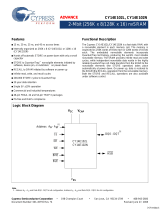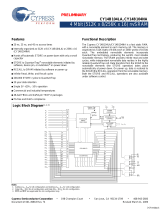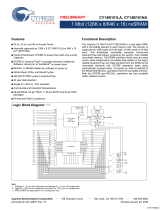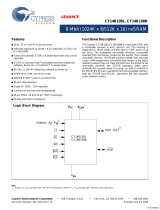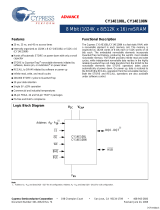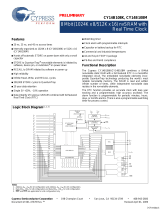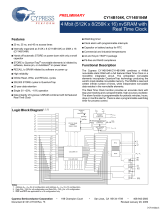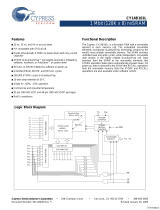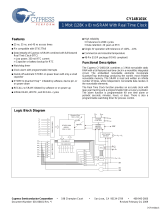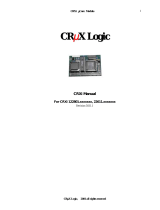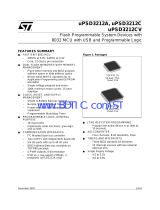Page is loading ...

PRELIMINARY
CY14B102L, CY14B102N
2 Mbit (256K x 8/128K x 16) nvSRAM
Cypress Semiconductor Corporation • 198 Champion Court • San Jose, CA 95134-1709 • 408-943-2600
Document #: 001-45754 Rev. *B Revised November 10, 2008
Features
■ 20 ns, 25 ns, and 45 ns Access Times
■ Internally organized as 256K x 8 (CY14B102L) or 128K x 16
(CY14B102N)
■ Hands off Automatic STORE on power down with only a small
Capacitor
■ STORE to QuantumTrap
®
nonvolatile elements initiated by
software, device pin, or AutoStore
®
on power down
■ RECALL to SRAM initiated by software or power up
■ Infinite Read, Write, and Recall Cycles
■ 200,000 STORE cycles to QuantumTrap
■ 20 year data retention
■ Single 3V +20% to -10% operation
■ Commercial, Industrial and Automotive Temperatures
■ 48-ball FBGA and 44/54-pin TSOP - II packages
■ Pb-free and RoHS compliance
Functional Description
The Cypress CY14B102L/CY14B102N is a fast static RAM, with
a nonvolatile element in each memory cell. The memory is
organized as 256K bytes of 8 bits each or 128K words of 16 bits
each. The embedded nonvolatile elements incorporate
QuantumTrap technology, producing the world’s most reliable
nonvolatile memory. The SRAM provides infinite read and write
cycles, while independent nonvolatile data resides in the highly
reliable QuantumTrap cell. Data transfers from the SRAM to the
nonvolatile elements (the STORE operation) takes place
automatically at power down. On power up, data is restored to
the SRAM (the RECALL operation) from the nonvolatile memory.
Both the STORE and RECALL operations are also available
under software control.
67$7,&5$0
$55$<
;
5
2
:
'
(
&
2
'
(
5
&2/801,2
&2/801'(&
,
1
3
8
7
%
8
)
)
(
5
6
32:(5
&21752/
6725(5(&$//
&21752/
4XDWUXP7UDS
;
6725(
5(&$//
9
&&
9
&$3
+6%
$
$
$
$
$
$
$
$
62)7:$5(
'(7(&7
$
$
2(
&(
:(
%+(
%/(
$
$
$
$
$
$
$
$
$
$
'4
'4
'4
'4
'4
'4
'4
'4
'4
'4
'4
'4
'4
'4
'4
'4
Logic Block Diagram
[1, 2, 3]
Note
1. Address A
0
- A
17
for x8 configuration and Address A
0
- A
16
for x16 configuration.
2. Data DQ
0
- DQ
7
for x8 configuration and Data DQ
0
- DQ
15
for x16 configuration.
3. BHE
and BLE are applicable for x16 configuration only.
[+] Feedback

PRELIMINARY
CY14B102L, CY14B102N
Document #: 001-45754 Rev. *B Page 2 of 24
Pinouts
Figure 1. Pin Diagram - 48 FBGA
Figure 2. Pin Diagram - 44 Pin TSOP II
48-FBGA
(not to scale)
Top View
(x8)
48-FBGA
(not to scale)
Top View
(x16)
WE
V
CC
A
11
A
10
V
CAP
A
6
A
0
A
3
CE
NC
NC
DQ0
A
4
A
5
NC
DQ2
DQ3
NC
V
SS
A
9
A
8
OE
V
SS
A
7
NC
NC
NC
A
17
A
2
A
1
NC
V
CC
DQ4
NC
DQ5
DQ6
NC
DQ7
NC
A
15
A
14
A
13
A
12
HSB
3
2
6
5
4
1
D
E
B
A
C
F
G
H
A
16
NC
DQ1
NC
[6]
[4]
[5]
WE
V
CC
A
11
A
10
V
CAP
A
6
A
0
A
3
CE
DQ10
DQ8
DQ9
A
4
A
5
DQ13
DQ12
DQ14
DQ15
V
SS
A
9
A
8
OE
V
SS
A
7
DQ0
BHE
NC
NC
A
2
A
1
BLE
V
CC
DQ2
DQ1
DQ3
DQ4
DQ5
DQ6
DQ7
A
15
A
14
A
13
A
12
HSB
3
2
6
5
4
1
D
E
B
A
C
F
G
H
A
16
NC
NC
DQ11
[6]
[5]
[4]
Notes
4. Address expansion for 4 Mbit. NC pin not connected to die.
5. Address expansion for 8 Mbit. NC pin not connected to die.
6. Address expansion for 16 Mbit. NC pin not connected to die.
7. HSB
pin is not available in 44-TSOP II (x16) package.
44-TSOP II
(x16)
44-TSOP II
(x8)
[7]
NC
A
8
NC
NC
V
SS
DQ6
DQ5
DQ4
V
CC
A
13
DQ3
A
12
DQ2
DQ1
DQ0
OE
A
9
CE
NC
A
0
A
1
A
2
A
3
A
4
A
5
A
6
A
11
A
7
A
14
A
15
A
16
A
17
NC
NC
1
2
3
4
5
6
7
8
9
10
11
12
13
14
15
16
17
18
19
20
21
22
23
24
25
26
27
28
29
30
31
32
33
34
35
36
37
38
39
40
41
42
43
44
A
10
NC
WE
DQ7
HSB
NC
V
SS
V
CC
V
CAP
NC
(x8)
[6]
[4]
[5]
V
SS
DQ6
DQ5
DQ4
V
CC
A
13
DQ3
A
12
DQ2
DQ1
DQ0
BLE
A
9
CE
A
1
A
2
A
3
A
4
A
5
A
6
A
7
A
8
A
11
A
10
A
14
BHE
OE
A
15
A
16
NC
1
2
3
4
5
6
7
8
9
10
11
12
13
14
15
16
17
18
19
20
21
22
23
24
25
26
27
28
29
30
31
32
33
34
35
36
37
38
39
40
41
42
43
44
WE
DQ7
A
0
V
SS
V
CC
DQ15
DQ14
DQ13
DQ12
DQ11
DQ10
DQ9
DQ8
V
CAP
(x16)
[4]
(Not to Scale)
(Not to Scale)
[+] Feedback

PRELIMINARY
CY14B102L, CY14B102N
Document #: 001-45754 Rev. *B Page 3 of 24
Figure 3. Pin Diagram - 54 Pin TSOP II (x16)
Pin Definitions
Pin Name IO Type Description
A
0
– A
17
Input Address Inputs Used to Select one of the 262,144 bytes of the nvSRAM for x8 Configuration.
A
0
– A
16
Address Inputs Used to Select one of the 131,072 words of the nvSRAM for x16 Configuration.
DQ
0
– DQ
7
Input/Output Bidirectional Data IO Lines for x8 Configuration. Used as input or output lines depending on
operation.
DQ
0
– DQ
15
Bidirectional Data IO Lines for x16 Configuration. Used as input or output lines depending on
operation.
WE
Input Write Enable Input, Active LOW. When selected LOW, data on the IO pins is written to the specific
address location.
CE
Input Chip Enable Input, Active LOW. When LOW, selects the chip. When HIGH, deselects the chip.
OE
Input Output Enable, Active LOW. The active LOW OE input enables the data output buffers during read
cycles. IO pins are tri-stated on deasserting OE
HIGH.
BHE
Input Byte High Enable, Active LOW. Controls DQ
15
- DQ
8
.
BLE
Input Byte Low Enable, Active LOW. Controls DQ
7
- DQ
0
.
V
SS
Ground Ground for the Device. Must be connected to the ground of the system.
V
CC
Power Supply Power Supply Inputs to the Device.
HSB
[7]
Input/Output Hardware Store Busy (HSB). When LOW this output indicates that a hardware store is in progress.
When pulled LOW external to the chip it initiates a nonvolatile STORE operation. A weak internal pull
up resistor keeps this pin HIGH if not connected (connection optional). After each store operation HSB
will be driven HIGH for short time with standard output high current.
V
CAP
Power Supply AutoStore Capacitor. Supplies power to the nvSRAM during power loss to store data from SRAM to
nonvolatile elements.
NC No Connect No Connect. This pin is not connected to the die.
Pinouts (continued)
NC
DQ7
DQ6
DQ5
DQ4
V
CC
DQ3
DQ2
DQ1
DQ0
NC
A
0
A
1
A
2
A
3
A
4
A
5
A
6
A
7
V
CAP
WE
A
8
A
10
A
11
A
12
A
13
A
14
A
15
A
16
1
2
3
4
5
6
7
8
9
10
11
12
13
14
15
16
17
18
19
20
21
22
23
24
25
26
27
28
29
30
31
32
33
34
35
36
37
38
39
40
41
42
43
44
45
46
47
48
OE
CE
V
CC
NC
V
SS
NC
A
9
NC
NC
NC
NC
NC
NC
54
53
52
51
49
50
HSB
BHE
BLE
DQ15
DQ14
DQ13
DQ12
V
SS
DQ11
DQ10
DQ9
DQ8
(x16)
[6]
[4]
[5]
(Not to Scale)
[+] Feedback

PRELIMINARY
CY14B102L, CY14B102N
Document #: 001-45754 Rev. *B Page 4 of 24
Device Operation
The CY14B102L/CY14B102N nvSRAM is made up of two
functional components paired in the same physical cell. They are
an SRAM memory cell and a nonvolatile QuantumTrap cell. The
SRAM memory cell operates as a standard fast static RAM. Data
in the SRAM is transferred to the nonvolatile cell (the STORE
operation), or from the nonvolatile cell to the SRAM (the RECALL
operation). Using this unique architecture, all cells are stored and
recalled in parallel. During the STORE and RECALL operations,
SRAM read and write operations are inhibited. The
CY14B102L/CY14B102N supports infinite reads and writes
similar to a typical SRAM. In addition, it provides infinite RECALL
operations from the nonvolatile cells and up to 200K STORE
operations. See the “Truth Table For SRAM Operations” on
page 15 for a complete description of read and write modes.
SRAM Read
The CY14B102L/CY14B102N performs a read cycle when CE
and OE are LOW and WE and HSB are HIGH. The address
specified on pins A
0-17
or A
0-16
determines which of the 262,144
data bytes or 131,072 words of 16 bits each are accessed. Byte
enables (BHE, BLE) determine which bytes are enabled to the
output, in the case of 16-bit words. When the read is initiated by
an address transition, the outputs are valid after a delay of t
AA
(read cycle 1). If the read is initiated by CE or OE, the outputs
are valid at t
ACE
or at t
DOE
, whichever is later (read cycle 2). The
data output repeatedly responds to address changes within the
t
AA
access time without the need for transitions on any control
input pins. This remains valid until another address change or
until CE or OE is brought HIGH, or WE or HSB is brought LOW.
SRAM Write
A write cycle is performed when CE and WE are LOW and HSB
is HIGH. The address inputs must be stable before entering the
write cycle and must remain stable until CE
or WE goes HIGH at
the end of the cycle. The data on the common IO pins DQ
0–15
are written into the memory if the data is valid t
SD
before the end
of a WE
controlled write or before the end of an CE controlled
write. The Byte Enable inputs (BHE
, BLE) determine which bytes
are written, in the case of 16-bit words. It is recommended that
OE
be kept HIGH during the entire write cycle to avoid data bus
contention on common IO lines. If OE
is left LOW, internal
circuitry turns off the output buffers t
HZWE
after WE goes LOW.
AutoStore Operation
The CY14B102L/CY14B102N stores data to the nvSRAM using
one of the following three storage operations: Hardware Store
activated by HSB;
Software Store activated by an address
sequence; AutoStore on device power down. The AutoStore
operation is a unique feature of QuantumTrap technology and is
enabled by default on the CY14B102L/CY14B102N.
During a normal operation, the device draws current from V
CC
to
charge a capacitor connected to the V
CAP
pin. This stored
charge is used by the chip to perform a single STORE operation.
If the voltage on the V
CC
pin drops below V
SWITCH
, the part
automatically disconnects the V
CAP
pin from V
CC
. A STORE
operation is initiated with power provided by the V
CAP
capacitor.
Figure 4 shows the proper connection of the storage capacitor
(V
CAP
) for automatic store operation. Refer to DC Electrical
Characteristics on page 7 for the size of V
CAP
. The voltage on
the V
CAP
pin is driven to V
CC
by a regulator on the chip. A pull
up should be placed on WE
to hold it inactive during power up.
This pull up is only effective if the WE
signal is tri-state during
power up. Many MPUs tri-state their controls on power up. This
should be verified when using the pull up. When the nvSRAM
comes out of power-on-recall, the MPU must be active or the WE
held inactive until the MPU comes out of reset.
To reduce unnecessary nonvolatile stores, AutoStore and
hardware store operations are ignored unless at least one write
operation has taken place since the most recent STORE or
RECALL cycle. Software initiated STORE cycles are performed
regardless of whether a write operation has taken place. The
HSB
signal is monitored by the system to detect if an AutoStore
cycle is in progress.
Figure 4. AutoStore Mode
Hardware STORE Operation
The CY14B102L/CY14B102N provides the HSB
[7]
pin to control
and acknowledge the STORE operations. Use the HSB
pin to
request a hardware STORE cycle. When the HSB
pin is driven
LOW, the CY14B102L/CY14B102N conditionally initiates a
STORE operation after t
DELAY
. An actual STORE cycle only
begins if a write to the SRAM has taken place since the last
STORE or RECALL cycle. The HSB
pin also acts as an open
drain driver that is internally driven LOW to indicate a busy
condition when the STORE (initiated by any means) is in
progress.
SRAM read and write operations that are in progress when HSB
is driven LOW by any means are given time to complete before
the STORE operation is initiated. After HSB
goes LOW, the
CY14B102L/CY14B102N continues SRAM operations for
t
DELAY
. If a write is in progress when HSB is pulled LOW it is
enabled a time, t
DELAY
to complete. However, any SRAM write
cycles requested after HSB
goes LOW are inhibited until HSB
returns HIGH. In case the write latch is not set, HSB will not be
driven LOW by the CY14B102L/CY14B102N but any SRAM
read and write cycles are inhibited until HSB
is returned HIGH by
MPU or other external source.
During any STORE operation, regardless of how it is initiated,
the CY14B102L/CY14B102N continues to drive the HSB
pin
LOW, releasing it only when the STORE is complete. Upon
0.1uF
Vcc
10kOhm
V
CAP
Vcc
WE
V
CAP
V
SS
[+] Feedback

PRELIMINARY
CY14B102L, CY14B102N
Document #: 001-45754 Rev. *B Page 5 of 24
completion of the STORE operation, the
CY14B102L/CY14B102N remains disabled until the HSB
pin
returns HIGH. Leave the HSB
unconnected if it is not used.
Hardware RECALL (Power Up)
During power up or after any low power condition
(V
CC
<V
SWITCH
), an internal RECALL request is latched. When
V
CC
again exceeds the sense voltage of V
SWITCH
, a RECALL
cycle is automatically initiated and takes t
HRECALL
to complete.
During this time, HSB
will be driven LOW by the HSB driver.
Software STORE
Transfer data from the SRAM to the nonvolatile memory with a
software address sequence. The CY14B102L/CY14B102N
software STORE cycle is initiated by executing sequential CE
controlled read cycles from six specific address locations in
exact order. During the STORE cycle an erase of the previous
nonvolatile data is first performed, followed by a program of the
nonvolatile elements. After a STORE cycle is initiated, further
input and output are disabled until the cycle is completed.
Because a sequence of READs from specific addresses is used
for STORE initiation, it is important that no other read or write
accesses intervene in the sequence, or the sequence is aborted
and no STORE or RECALL takes place.
To initiate the software STORE cycle, the following read
sequence must be performed.
1. Read Address 0x4E38 Valid READ
2. Read Address 0xB1C7 Valid READ
3. Read Address 0x83E0 Valid READ
4. Read Address 0x7C1F Valid READ
5. Read Address 0x703F Valid READ
6. Read Address 0x8FC0 Initiate STORE Cycle
The software sequence may be clocked with CE
controlled reads
or OE
controlled reads. After the sixth address in the sequence
is entered, the STORE cycle commences and the chip is
disabled. HSB
will be driven LOW. It is important to use read
cycles and not write cycles in the sequence, although it is not
necessary that OE be LOW for a valid sequence. After the
t
STORE
cycle time is fulfilled, the SRAM is activated again for the
read and write operation.
Software RECALL
Transfer the data from the nonvolatile memory to the SRAM with
a software address sequence. A software RECALL cycle is
initiated with a sequence of read operations in a manner similar
to the software STORE initiation. To initiate the RECALL cycle,
the following sequence of CE
controlled read operations must be
performed.
1. Read Address 0x4E38 Valid READ
2. Read Address 0xB1C7 Valid READ
3. Read Address 0x83E0 Valid READ
4. Read Address 0x7C1F Valid READ
5. Read Address 0x703F Valid READ
6. Read Address 0x4C63 Initiate RECALL Cycle
Internally, RECALL is a two step procedure. First, the SRAM data
is cleared; then, the nonvolatile information is transferred into the
SRAM cells. After the t
RECALL
cycle time, the SRAM is again
ready for read and write operations. The RECALL operation
does not alter the data in the nonvolatile elements.
Table 1. Mode Selection
CE WE OE, BHE, BLE
[3]
A
15
- A
0
[8]
Mode IO Power
H X X X Not Selected Output High Z Standby
L H L X Read SRAM Output Data Active
L L X X Write SRAM Input Data Active
L H L 0x4E38
0xB1C7
0x83E0
0x7C1F
0x703F
0x8B45
Read SRAM
Read SRAM
Read SRAM
Read SRAM
Read SRAM
AutoStore
Disable
Output Data
Output Data
Output Data
Output Data
Output Data
Output Data
Active
[9, 10]
Notes
8. While there are 18 address lines on the CY14B102L (17 address lines on the CY14B102N), only the 13 address lines (A
14
- A
2
) are used to control software modes.
Rest of the address lines are don’t care.
9. The six consecutive address locations must be in the order listed. WE
must be HIGH during all six cycles to enable a nonvolatile cycle.
10. IO state depends on the state of OE
, BHE, and BLE. The IO table shown assumes OE, BHE, and BLE LOW.
[+] Feedback

PRELIMINARY
CY14B102L, CY14B102N
Document #: 001-45754 Rev. *B Page 6 of 24
Preventing AutoStore
The AutoStore function is disabled by initiating an AutoStore
disable sequence. A sequence of read operations is performed
in a manner similar to the software STORE initiation. To initiate
the AutoStore disable sequence, the following sequence of CE
controlled read operations must be performed:
1. Read address 0x4E38 Valid READ
2. Read address 0xB1C7 Valid READ
3. Read address 0x83E0 Valid READ
4. Read address 0x7C1F Valid READ
5. Read address 0x703F Valid READ
6. Read address 0x8B45 AutoStore Disable
The AutoStore is re-enabled by initiating an AutoStore enable
sequence. A sequence of read operations is performed in a
manner similar to the software RECALL initiation. To initiate the
AutoStore enable sequence, the following sequence of CE
controlled read operations must be performed:
1. Read address 0x4E38 Valid READ
2. Read address 0xB1C7 Valid READ
3. Read address 0x83E0 Valid READ
4. Read address 0x7C1F Valid READ
5. Read address 0x703F Valid READ
6. Read address 0x4B46 AutoStore Enable
If the AutoStore function is disabled or re-enabled, a manual
STORE operation (hardware or software) must be issued to save
the AutoStore state through subsequent power down cycles. The
part comes from the factory with AutoStore enabled.
Data Protection
The CY14B102L/CY14B102N protects data from corruption
during low voltage conditions by inhibiting all externally initiated
STORE and write operations. The low voltage condition is
detected when V
CC
< V
SWITCH
. If the CY14B102L/CY14B102N
is in a write mode (both CE
and WE are LOW) at power up, after
a RECALL or STORE, the write is inhibited until the SRAM is
enabled after t
LZHSB
(HSB to output active). This protects against
inadvertent writes during power up or brown out conditions.
Noise Considerations
Refer to CY application note AN1064.
L H L 0x4E38
0xB1C7
0x83E0
0x7C1F
0x703F
0x4B46
Read SRAM
Read SRAM
Read SRAM
Read SRAM
Read SRAM
AutoStore Enable
Output Data
Output Data
Output Data
Output Data
Output Data
Output Data
Active
[9, 10]
L H L 0x4E38
0xB1C7
0x83E0
0x7C1F
0x703F
0x8FC0
Read SRAM
Read SRAM
Read SRAM
Read SRAM
Read SRAM
Nonvolatile Store
Output Data
Output Data
Output Data
Output Data
Output Data
Output High Z
Active I
CC2
[9, 10]
L H L 0x4E38
0xB1C7
0x83E0
0x7C1F
0x703F
0x4C63
Read SRAM
Read SRAM
Read SRAM
Read SRAM
Read SRAM
Nonvolatile
Recall
Output Data
Output Data
Output Data
Output Data
Output Data
Output High Z
Active
[9, 10]
Table 1. Mode Selection (continued)
CE WE OE, BHE, BLE
[3]
A
15
- A
0
[8]
Mode IO Power
[+] Feedback

PRELIMINARY
CY14B102L, CY14B102N
Document #: 001-45754 Rev. *B Page 7 of 24
Maximum Ratings
Exceeding maximum ratings may impair the useful life of the
device. These user guidelines are not tested.
Storage Temperature ................................. –65°C to +150°C
Maximum Accumulated Storage Time
............At 150°C Ambient Temperature........................1000h
............At 85°C Ambient Temperature..................... 20 Years
Ambient Temperature with
Power Applied ............................................ –55°C to +150°C
Supply Voltage on V
CC
Relative to GND ..........–0.5V to 4.1V
Voltage Applied to Outputs
in High-Z State....................................... –0.5V to V
CC
+ 0.5V
Input Voltage...........................................–0.5V to Vcc + 0.5V
Transient Voltage (<20 ns) on
Any Pin to Ground Potential .................. –2.0V to V
CC
+ 2.0V
Package Power Dissipation
Capability (T
A
= 25°C) ................................................... 1.0W
Surface Mount Pb Soldering
Temperature (3 Seconds) .......................................... +260°C
DC Output Current (1 output at a time, 1s duration).... 15 mA
Static Discharge Voltage.......................................... > 2001V
(per MIL-STD-883, Method 3015)
Latch Up Current ................................................... > 200 mA
Operating Range
Range Ambient Temperature V
CC
Commercial 0°C to +70°C 2.7V to 3.6V
Industrial –40°C to +85°C 2.7V to 3.6V
Automotive –40°C to +125°C 2.7V to 3.6V
DC Electrical Characteristics
Over the Operating Range (V
CC
= 2.7V to 3.6V)
Parameter Description Test Conditions Min Max Unit
I
CC1
Average V
CC
Current t
RC
= 20 ns
t
RC
= 25 ns
t
RC
= 45 ns
Values obtained without output loads (I
OUT
= 0 mA)
Commercial 65
65
50
mA
mA
mA
Industrial 70
70
52
mA
mA
mA
t
RC
= 25 ns
t
RC
= 45 ns
Values obtained without output loads (I
OUT
= 0 mA)
Automotive 90
75
mA
mA
I
CC2
Average V
CC
Current
during STORE
All Inputs Don’t Care, V
CC
= Max
Average current for duration t
STORE
10 mA
I
CC3
[11]
Average V
CC
Current at
t
RC
= 200 ns, 3V, 25°C
typical
All I/P cycling at CMOS levels.
Values obtained without output loads (I
OUT
= 0 mA).
35 mA
I
CC4
Average V
CAP
Current
during AutoStore Cycle
All Inputs Don’t Care, V
CC
= Max
Average current for duration t
STORE
5mA
I
SB
V
CC
Standby Current CE > (V
CC
– 0.2). All others V
IN
< 0.2V or > (V
CC
– 0.2V). Standby
current level after nonvolatile cycle is complete.
Inputs are static. f = 0 MHz.
5mA
I
IX
[12]
Input Leakage Current
(except HSB
)
V
CC
= Max, V
SS
< V
IN
< V
CC
–1 +1 μA
Input Leakage Current
(for HSB
)
V
CC
= Max, V
SS
< V
IN
< V
CC
–100 +1 μA
I
OZ
Off-State Output
Leakage Current
V
CC
= Max, V
SS
< V
OUT
< V
CC
, CE or OE > V
IH
or BHE/BLE > V
IH
or WE < V
IL
–1 +1 μA
V
IH
Input HIGH Voltage 2.0 V
CC
+
0.5
V
V
IL
Input LOW Voltage V
ss
– 0.5 0.8 V
V
OH
Output HIGH Voltage I
OUT
= –2 mA 2.4 V
V
OL
Output LOW Voltage I
OUT
= 4 mA 0.4 V
V
CAP
[13]
Storage Capacitor Between V
CAP
pin and V
SS
, 5V Rated 61 180 μF
Notes
11. Typical conditions for the active current shown on the DC Electrical characteristics are average values at 25°C (room temperature), and V
CC
= 3V. Not 100% tested.
12. The HSB
pin has I
OUT
= -2 uA for V
OH
of 2.4V when both active HIGH and LOW drivers are disabled. When they are enabled standard V
OH
and V
OL
are valid. This
parameter is characterized but not tested.
13. V
CAP
(Storage capacitor) nominal value is 68uF.
[+] Feedback

PRELIMINARY
CY14B102L, CY14B102N
Document #: 001-45754 Rev. *B Page 8 of 24
AC Test Conditions
Input Pulse Levels.................................................... 0V to 3V
Input Rise and Fall Times (10% - 90%)........................ <
3 ns
Input and Output Timing Reference Levels.................... 1.5V
Data Retention and Endurance
Parameter Description Min Unit
DATA
R
Data Retention 20 Years
NV
C
Nonvolatile STORE Operations 200 K
Capacitance
In the following table, the capacitance parameters are listed.
[14]
Parameter Description Test Conditions Max Unit
C
IN
Input Capacitance T
A
= 25°C, f = 1 MHz,
V
CC
= 0 to 3.0V
7pF
C
OUT
Output Capacitance 7 pF
Thermal Resistance
In the following table, the thermal resistance parameters are listed.
[14]
Parameter Description Test Conditions 48-FBGA 44-TSOP II 54-TSOP II Unit
Θ
JA
Thermal Resistance
(Junction to Ambient)
Test conditions follow standard test methods
and procedures for measuring thermal
impedance, in accordance with EIA/JESD51.
28.82 31.11 30.73 °C/W
Θ
JC
Thermal Resistance
(Junction to Case)
7.84 5.56 6.08 °C/W
Figure 5. AC Test Loads
3.0V
OUTPUT
5 pF
R1
R2
789Ω
3.0V
OUTPUT
30 pF
R1
R2
789Ω
for tri-state specs
577Ω
577Ω
Note
14. These parameters are guaranteed but not tested.
[+] Feedback

PRELIMINARY
CY14B102L, CY14B102N
Document #: 001-45754 Rev. *B Page 9 of 24
AC Switching Characteristics
Parameters
Description
20 ns 25 ns 45 ns
Unit
Cypress
Parameters
Alt
Parameters
Min Max Min Max Min Max
SRAM Read Cycle
t
ACE
t
ACS
Chip Enable Access Time 20 25 45 ns
t
RC
[15]
t
RC
Read Cycle Time 20 25 45 ns
t
AA
[16]
t
AA
Address Access Time 20 25 45 ns
t
DOE
t
OE
Output Enable to Data Valid 10 12 20 ns
t
OHA
[16]
t
OH
Output Hold After Address Change 3 3 3 ns
t
LZCE
[17]
t
LZ
Chip Enable to Output Active 3 3 3 ns
t
HZCE
[17]
t
HZ
Chip Disable to Output Inactive 8 10 15 ns
t
LZOE
[17]
t
OLZ
Output Enable to Output Active 0 0 0 ns
t
HZOE
[17]
t
OHZ
Output Disable to Output Inactive 8 10 15 ns
t
PU
[14]
t
PA
Chip Enable to Power Active 0 0 0 ns
t
PD
[14]
t
PS
Chip Disable to Power Standby 20 25 45 ns
t
DBE
- Byte Enable to Data Valid 10 12 20 ns
t
LZBE
- Byte Enable to Output Active 0 0 0 ns
t
HZBE
- Byte Disable to Output Inactive 8 10 15 ns
SRAM Write Cycle
t
WC
t
WC
Write Cycle Time 20 25 45 ns
t
PWE
t
WP
Write Pulse Width 15 20 30 ns
t
SCE
t
CW
Chip Enable To End of Write 15 20 30 ns
t
SD
t
DW
Data Setup to End of Write 8 10 15 ns
t
HD
t
DH
Data Hold After End of Write 0 0 0 ns
t
AW
t
AW
Address Setup to End of Write 15 20 30 ns
t
SA
t
AS
Address Setup to Start of Write 0 0 0 ns
t
HA
t
WR
Address Hold After End of Write 0 0 0 ns
t
HZWE
[17,18]
t
WZ
Write Enable to Output Disable 8 10 15 ns
t
LZWE
[17]
t
OW
Output Active after End of Write 3 3 3 ns
t
BW
- Byte Enable to End of Write 15 20 30 ns
Switching Waveforms
Figure 6. SRAM Read Cycle #1: Address Controlled
[15, 16, 19]
$GGUHVV
'DWD2XWSXW
$GGUHVV9DOLG
3UHYLRXV'DWD9DOLG
2XWSXW'DWD9DOLG
W
5&
W
$$
W
2+$
Notes
15. WE
must be HIGH during SRAM read cycles.
16. Device is continuously selected with CE
, OE and BHE / BLE LOW.
17. Measured ±200 mV from steady state output voltage.
18. If WE
is LOW when CE goes LOW, the outputs remain in the high impedance state.
19. HSB
must remain HIGH during READ and WRITE cycles.
[+] Feedback

PRELIMINARY
CY14B102L, CY14B102N
Document #: 001-45754 Rev. *B Page 10 of 24
Figure 7. SRAM Read Cycle #2: CE
and OE Controlled
[3, 15, 19]
Figure 8. SRAM Write Cycle #1: WE Controlled
[3, 18, 19, 20]
$GGUHVV9DOLG$GGUHVV
'DWD2XWSXW
2XWSXW'DWD9DOLG
6WDQGE\
$FWLYH
+LJK,PSHGDQFH
&(
2(
%+(%/(
,
&&
W
+=&(
W
5&
W
$&(
W
$$
W
/=&(
W
'2(
W
/=2(
W
'%(
W
/=%(
W
38
W
3'
W
+=%(
W
+=2(
'DWD2XWSXW
'DWD,QSXW
,QSXW'DWD9DOLG
+LJK,PSHGDQFH
$GGUHVV9DOLG$GGUHVV
3UHYLRXV'DWD
W
:&
W
6&(
W
+$
W
%:
W
$:
W
3:(
W
6$
W
6'
W
+'
W
+=:(
W
/=:(
:(
%+(%/(
&(
Notes
20. CE
or WE must be >V
IH
during address transitions.
[+] Feedback

PRELIMINARY
CY14B102L, CY14B102N
Document #: 001-45754 Rev. *B Page 11 of 24
Figure 9. SRAM Write Cycle #2: CE
Controlled
[3, 18, 19, 20]
Figure 10. SRAM Write Cycle #3: BHE and BLE Controlled
[3, 18, 19, 20]
'DWD2XWSXW
'DWD,QSXW
,QSXW'DWD9DOLG
+LJK,PSHGDQFH
$GGUHVV9DOLG$GGUHVV
W
:&
W
6'
W
+'
%+(%/(
:(
&(
W
6&(
W
6$
W
%:
W
+$
W
$:
W
3:(
'DWD2XWSXW
'DWD,QSXW
,QSXW'DWD9DOLG
+LJK,PSHGDQFH
$GGUHVV9DOLG$GGUHVV
W
:&
W
6'
W
+'
%+(%/(
:(
&(
W
6&(
W
6$
W
%:
W
+$
W
$:
W
3:(
[+] Feedback

PRELIMINARY
CY14B102L, CY14B102N
Document #: 001-45754 Rev. *B Page 12 of 24
AutoStore/Power Up RECALL
Parameters Description
20 ns 25 ns 45 ns
Unit
Min Max Min Max Min Max
t
HRECALL
[21]
Power Up RECALL Duration 20 20 20 ms
t
STORE
[22]
STORE Cycle Duration 8 8 8 ms
t
DELAY
[23]
Time Allowed to Complete SRAM Cycle 20 25 25 ns
V
SWITCH
Low Voltage Trigger Level 2.65 2.65 2.65 V
t
VCCRISE
VCC Rise Time 150 150 150 μs
V
HDIS
[14]
HSB Output Driver Disable Voltage 1.9 1.9 1.9 V
t
LZHSB
HSB To Output Active Time 5 5 5 μs
t
HHHD
HSB High Active Time 500 500 500 ns
Switching Waveforms
Figure 11. AutoStore or Power Up RECALL
[24]
9
6:,7&+
9
+',6
9
9&&5,6(
W
6725(
W
6725(
W
+++'
W
+++'
W
'(/$<
W
'(/$<
W
/=+6%
W
/=+6%
W
+5(&$//
W
+5(&$//
+6%287
$XWRVWRUH
32:(5
83
5(&$//
5HDG:ULWH
,QKLELWHG
5:,
32:(583
5(&$//
5HDG:ULWH
%52:1
287
$XWRVWRUH
32:(583
5(&$//
5HDG:ULWH
32:(5
'2:1
$XWRVWRUH
1RWH
1RWH
1RWH
Notes
21. t
HRECALL
starts from the time V
CC
rises above V
SWITCH.
22. If an SRAM write has not taken place since the last nonvolatile cycle, no AutoStore or Hardware Store takes place.
23. On a Hardware STORE, Software Store / Recall, AutoStore Enable / Disable and AutoStore initiation, SRAM operation continues to be enabled for time t
DELAY
.
24. Read and Write cycles are ignored during STORE, RECALL, and while VCC is below V
SWITCH.
25. HSB pin is driven HIGH to VCC only by internal 100kOhm resistor, HSB driver is disabled.
[+] Feedback

PRELIMINARY
CY14B102L, CY14B102N
Document #: 001-45754 Rev. *B Page 13 of 24
Software Controlled STORE/RECALL Cycle
In the following table, the software controlled STORE/RECALL cycle parameters are listed.
[26, 27]
Parameters Description
20 ns 25 ns 45 ns
Unit
Min Max Min Max Min Max
t
RC
STORE/RECALL Initiation Cycle Time 20 25 45 ns
t
SA
Address Setup Time 0 0 0 ns
t
CW
Clock Pulse Width 15 20 30 ns
t
HA
Address Hold Time 0 0 0 ns
t
RECALL
RECALL Duration 200 200 200 μs
Switching Waveforms
Figure 12. CE and OE Controlled Software STORE/RECALL Cycle
[27]
Figure 13. Autostore Enable/Disable Cycle
W
5&
W
5&
W
6$
W
&:
W
&:
W
6$
W
+$
W
/=&(
W
+=&(
W
+$
W
+$
W
+$
W
'(/$<
W
6725(
W
5(&$//
W
+++'
W
/=+6%
+LJK,PSHGDQFH
$GGUHVV $GGUHVV$GGUHVV
&(
2(
+6%6725(RQO\
'4'$7$
5:,
W
5&
W
5&
W
6$
W
&:
W
&:
W
6$
W
+$
W
/=&(
W
+=&(
W
+$
W
+$
W
+$
W
'(/$<
$GGUHVV $GGUHVV$GGUHVV
&(
2(
'4'$7$
5:,
W
66
Notes
26. The software sequence is clocked with CE
controlled or OE controlled reads.
27. The six consecutive addresses must be read in the order listed in Table 1 on page 5. WE
must be HIGH during all six consecutive cycles.
[+] Feedback

PRELIMINARY
CY14B102L, CY14B102N
Document #: 001-45754 Rev. *B Page 14 of 24
Hardware STORE Cycle
Parameters Description
20 ns 25 ns 45 ns
Unit
Min Max Min Max Min Max
t
DHSB
HSB To Output Active Time when write latch not set 20 25 25 ns
t
PHSB
Hardware STORE Pulse Width 15 15 15 ns
t
SS
[28, 29]
Soft Sequence Processing Time 100 100 100 μs
Switching Waveforms
Figure 14. Hardware STORE Cycle
[22]
Figure 15. Soft Sequence Processing
[28, 29]
W
3+6%
W
3+6%
W
'(/$<
W
'+6%
W
'(/$<
W
6725(
W
+++'
W
/=+6%
:ULWHODWFKVHW
:ULWHODWFKQRWVHW
+6%,1
+6%287
'4'DWD2XW
5:,
+6%,1
+6%287
5:,
+6%SLQLVGULYHQKLJKWR9
&&
RQO\E\,QWHUQDO
65$0LVGLVDEOHGDVORQJDV+6%,1LVGULYHQORZ
+6%GULYHULVGLVDEOHG
W
'+6%
N2KPUHVLVWRU
$GGUHVV $GGUHVV $GGUHVV $GGUHVV
6RIW6HTXHQFH
&RPPDQG
W
66
W
66
&(
$GGUHVV
9
&&
W
6$
W
&:
6RIW6HTXHQFH
&RPPDQG
W
&:
Notes
28. This is the amount of time it takes to take action on a soft sequence command. Vcc power must remain HIGH to effectively register command.
29. Commands such as STORE and RECALL lock out IO until operation is complete which further increases this time. See the specific command.
[+] Feedback

PRELIMINARY
CY14B102L, CY14B102N
Document #: 001-45754 Rev. *B Page 15 of 24
Truth Table For SRAM Operations
HSB should remain HIGH for SRAM Operations.
For x8 Configuration
CE WE OE Inputs/Outputs
[2]
Mode Power
H X X High Z Deselect/Power down Standby
L H L Data Out (DQ
0
–DQ
7
); Read Active
L H H High Z Output Disabled Active
L L X Data in (DQ
0
–DQ
7
); Write Active
For x16 Configuration
CE WE OE BHE BLE Inputs/Outputs
[2]
Mode Power
H X X X X High-Z Deselect/Power down Standby
L X X H H High-Z Output Disabled Active
L H L L L Data Out (DQ
0
–DQ
15
) Read Active
LHLHLData Out (DQ
0
–DQ
7
);
DQ
8
–DQ
15
in High-Z
Read Active
L H L L H Data Out (DQ
8
–DQ
15
);
DQ
0
–DQ
7
in High-Z
Read Active
L H H L L High-Z Output Disabled Active
L H H H L High-Z Output Disabled Active
L H H L H High-Z Output Disabled Active
L L X L L Data In (DQ
0
–DQ
15
) Write Active
L L X H L Data In (DQ
0
–DQ
7
);
DQ
8
–DQ
15
in High-Z
Write Active
L L X L H Data In (DQ
8
–DQ
15
);
DQ
0
–DQ
7
in High-Z
Write Active
[+] Feedback

PRELIMINARY
CY14B102L, CY14B102N
Document #: 001-45754 Rev. *B Page 16 of 24
Ordering Information
Speed
(ns)
Ordering Code
Package
Diagram
Package Type
Operating
Range
20 CY14B102L-ZS20XCT 51-85087 44-pin TSOP II Commercial
CY14B102L-ZS20XIT 51-85087 44-pin TSOP II Industrial
CY14B102L-ZS20XI 51-85087 44-pin TSOP II
CY14B102L-ZS20XAT 51-85087 44-pin TSOP II Automotive
CY14B102L-BA20XCT 51-85128 48-ball FBGA Commercial
CY14B102L-BA20XIT 51-85128 48-ball FBGA Industrial
CY14B102L-BA20XI 51-85128 48-ball FBGA
CY14B102L-BA20XAT 51-85128 48-ball FBGA Automotivel
CY14B102L-ZSP20XCT 51-85160 54-pin TSOP II Commercial
CY14B102L-ZSP20XIT 51-85160 54-pin TSOP II Industrial
CY14B102L-ZSP20XI 51-85160 54-pin TSOP II
CY14B102L-ZSP20XAT 51-85160 54-pin TSOP II Automotive
CY14B102N-ZS20XCT 51-85087 44-pin TSOP II Commercial
CY14B102N-ZS20XIT 51-85087 44-pin TSOP II Industrial
CY14B102N-ZS20XI 51-85087 44-pin TSOP II
CY14B102N-ZS20XAT 51-85087 44-pin TSOP II Automotive
CY14B102N-BA20XCT 51-85128 48-ball FBGA Commercial
CY14B102N-BA20XIT 51-85128 48-ball FBGA Industrial
CY14B102N-BA20XI 51-85128 48-ball FBGA
CY14B102N-BA20XAT 51-85128 48-ball FBGA Automotive
CY14B102N-ZSP20XCT 51-85160 54-pin TSOP II Commercial
CY14B102N-ZSP20XIT 51-85160 54-pin TSOP II Industrial
CY14B102N-ZSP20XI 51-85160 54-pin TSOP II
CY14B102N-ZSP20XAT 51-85160 54-pin TSOP II Automotive
[+] Feedback

PRELIMINARY
CY14B102L, CY14B102N
Document #: 001-45754 Rev. *B Page 17 of 24
25 CY14B102L-ZS25XCT 51-85087 44-pin TSOP II Commercial
CY14B102L-ZS25XIT 51-85087 44-pin TSOP II Industrial
CY14B102L-ZS25XI 51-85087 44-pin TSOP II
CY14B102L-ZS25XAT 51-85087 44-pin TSOP II Automotive
CY14B102N-BA25XCT 51-85128 48-ball FBGA Commercial
CY14B102L-BA25XIT 51-85128 48-ball FBGA Industrial
CY14B102L-BA25XI 51-85128 48-ball FBGA
CY14B102N-BA25XAT 51-85128 48-ball FBGA Automotive
CY14B102L-ZSP25XCT 51-85160 54-pin TSOP II Commercial
CY14B102L-ZSP25XIT 51-85160 54-pin TSOP II Industrial
CY14B102L-ZSP25XI 51-85160 54-pin TSOP II
CY14B102L-ZSP25XAT 51-85160 54-pin TSOP II Automotive
CY14B102N-ZS25XCT 51-85087 44-pin TSOP II Commercial
CY14B102N-ZS25XIT 51-85087 44-pin TSOP II Industrial
CY14B102N-ZS25XI 51-85087 44-pin TSOP II
CY14B102N-ZS25XAT 51-85087 44-pin TSOP II Automotive
CY14B102N-BA25XCT 51-85128 48-ball FBGA Commercial
CY14B102N-BA25XIT 51-85128 48-ball FBGA Industrial
CY14B102N-BA25XI 51-85128 48-ball FBGA
CY14B102N-BA25XAT 51-85128 48-ball FBGAI Automotive
CY14B102N-ZSP25XCT 51-85160 54-pin TSOP II Commercial
CY14B102N-ZSP25XIT 51-85160 54-pin TSOP II Industrial
CY14B102N-ZSP25XI 51-85160 54-pin TSOP II
CY14B102N-ZSP25XAT 51-85160 54-pin TSOP II Automotive
Ordering Information (continued)
Speed
(ns)
Ordering Code
Package
Diagram
Package Type
Operating
Range
[+] Feedback

PRELIMINARY
CY14B102L, CY14B102N
Document #: 001-45754 Rev. *B Page 18 of 24
45 CY14B102L-ZS45XCT 51-85087 44-pin TSOP II Commercial
CY14B102L-ZS45XIT 51-85087 44-pin TSOP II Industrial
CY14B102L-ZS45XI 51-85087 44-pin TSOP II
CY14B102L-ZS45XAT 51-85087 44-pin TSOP II Automotive
CY14B102L-BA45XCT 51-85128 48-ball FBGA Commercial
CY14B102L-BA45XIT 51-85128 48-ball FBGA Industrial
CY14B102L-BA45XI 51-85128 48-ball FBGA
CY14B102L-BA45XAT 51-85128 48-ball FBGA Automotive
CY14B102L-ZSP45XCT 51-85160 54-pin TSOP II Commercial
CY14B102L-ZSP45XIT 51-85160 54-pin TSOP II Industrial
CY14B102L-ZSP45XI 51-85160 54-pin TSOP II
CY14B102L-ZSP45XAT 51-85160 54-pin TSOP II Automotive
CY14B102N-ZS45XCT 51-85087 44-pin TSOP II Commercial
CY14B102N-ZS45XIT 51-85087 44-pin TSOP II Industrial
CY14B102N-ZS45XI 51-85087 44-pin TSOP II
CY14B102N-ZS45XAT 51-85087 44-pin TSOP II Automotive
CY14B102N-BA45XCT 51-85128 48-ball FBGA Commercial
CY14B102N-BA45XIT 51-85128 48-ball FBGA Industrial
CY14B102N-BA45XI 51-85128 48-ball FBGA
CY14B102N-BA45XAT 51-85128 48-ball FBGA Automotive
CY14B102N-ZSP45XCT 51-85160 54-pin TSOP II Commercial
CY14B102N-ZSP45XIT 51-85160 54-pin TSOP II Industrial
CY14B102N-ZSP45XI 51-85160 54-pin TSOP II
CY14B102N-ZSP45XAT 51-85160 54-pin TSOP II Automotive
All parts are Pb-free. The above table contains Preliminary information. Please contact your local Cypress sales representative for availability of these parts.
Ordering Information (continued)
Speed
(ns)
Ordering Code
Package
Diagram
Package Type
Operating
Range
[+] Feedback

PRELIMINARY
CY14B102L, CY14B102N
Document #: 001-45754 Rev. *B Page 19 of 24
Part Numbering Nomenclature
Option:
T - Tape & Reel
Blank - Std.
Speed:
20 - 20ns
45 - 45 ns
Data Bus:
L - x8
N - x16
Density:
102 - 2 Mb
Voltage:
B - 3.0V
Cypress
CY 14 B 102 L - ZS P 20 X C T
NVSRAM
14 - Auto Store + Software Store + Hardware Store
Temperature:
C - Commercial (0 to 70°C)
I - Industrial (–40 to 85°C)
Pb-Free
Package:
BA - 48 FBGA
ZS - TSOP II
P - 54 Pin
Blank - 44 Pin
A - Automotive (-40 to +125°C)
25 - 25ns
[+] Feedback

PRELIMINARY
CY14B102L, CY14B102N
Document #: 001-45754 Rev. *B Page 20 of 24
Package Diagrams
Figure 16. 44-Pin TSOP II (51-85087)
MAX
MIN.
DIMENSION IN MM (INCH)
11.938 (0.470)
PLANE
SEATING
PIN 1 I.D.
44
1
18.517 (0.729)
0.800 BSC
0°-5°
0.400(0.016)
0.300 (0.012)
EJECTOR PIN
R
G
O
K
E
A
X
S
11.735 (0.462)
10.058 (0.396)
10.262 (0.404)
1.194 (0.047)
0.991 (0.039)
0.150 (0.0059)
0.050 (0.0020)
(0.0315)
18.313 (0.721)
10.058 (0.396)
10.262 (0.404)
0.597 (0.0235)
0.406 (0.0160)
0.210 (0.0083)
0.120 (0.0047)
BASE PLANE
0.10 (.004)
22
23
TOP VIEW BOTTOM VIEW
51-85087-*A
[+] Feedback
/
